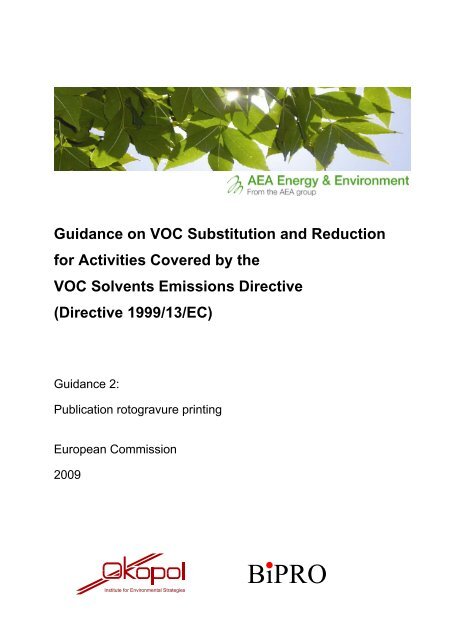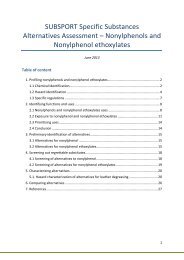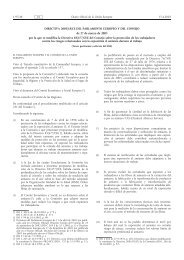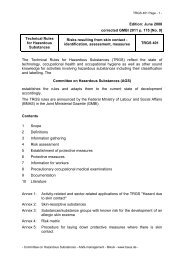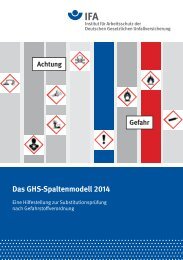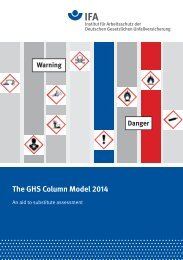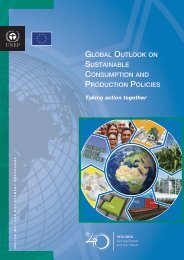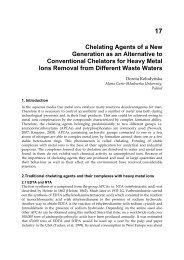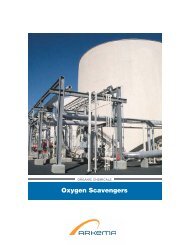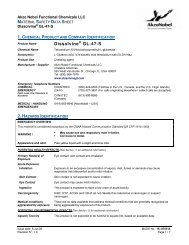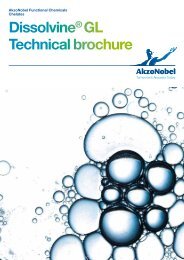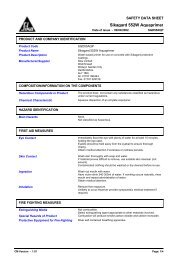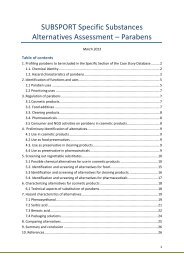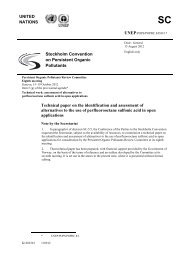Guidance on VOC reduction
Guidance on VOC reduction
Guidance on VOC reduction
Create successful ePaper yourself
Turn your PDF publications into a flip-book with our unique Google optimized e-Paper software.
<str<strong>on</strong>g>Guidance</str<strong>on</strong>g> 2Publicati<strong>on</strong> rotogravure printingC<strong>on</strong>tent1 Introducti<strong>on</strong> ............................................................................... 32 Summary of <strong>VOC</strong> substituti<strong>on</strong>/reducti<strong>on</strong> ................................... 43 Descripti<strong>on</strong> of the activity and related industry sector ............... 54 Technical process descripti<strong>on</strong>................................................... 54.1 Process flow and relevant associated <strong>VOC</strong> emissi<strong>on</strong>s.............. 64.2 Process descripti<strong>on</strong> ................................................................... 74.3 Inks ............................................................................................ 74.4 Cleaning system ........................................................................ 85 Solvent use, emissi<strong>on</strong>s and envir<strong>on</strong>mental impact.................... 85.1 Solvents used ............................................................................ 85.2 Solvent c<strong>on</strong>sumpti<strong>on</strong> and emissi<strong>on</strong> levels ................................. 85.3 Key envir<strong>on</strong>mental and health issues ........................................ 96 <strong>VOC</strong> substituti<strong>on</strong> ..................................................................... 106.1 <strong>VOC</strong>-free systems ................................................................... 106.2 <strong>VOC</strong>-reduced systems............................................................. 107 Other <strong>VOC</strong> emissi<strong>on</strong> preventi<strong>on</strong> measures and abatementtechniques............................................................................... 117.1 Process improvements ............................................................ 117.2 Waste gas abatement.............................................................. 128 Summary of <strong>VOC</strong> emissi<strong>on</strong> reducti<strong>on</strong> measures..................... 149 Good practice examples ......................................................... 1510 Emerging techniques and substitutes under development...... 1511 Informati<strong>on</strong> sources................................................................. 16March 2009 2/17
<str<strong>on</strong>g>Guidance</str<strong>on</strong>g> 2Publicati<strong>on</strong> rotogravure printing1 Introducti<strong>on</strong>This guidance addresses publicati<strong>on</strong> rotogravure printing and the relatedcleaning of equipment, presenting opti<strong>on</strong>s to substitute or reduce the use of<strong>VOC</strong> and its resulting emissi<strong>on</strong>s.Table: 1: Scope definiti<strong>on</strong> of the <strong>VOC</strong> Solvent Emissi<strong>on</strong> Directive (SE Directive)SE Directive – Scope definiti<strong>on</strong>s (Annex I)Printing is defined by the Directive as ‘any reproducti<strong>on</strong> activity of text and/or imagesin which, with the use of an image carrier, ink is transferred <strong>on</strong>to whatevertype of surface. It includes associated varnishing, coating and laminating techniques.’Rotogravure is defined as ‘a printing activity using a cylindrical image carrier inwhich the printing area is below the n<strong>on</strong>-printing area, using liquid inks which drythrough evaporati<strong>on</strong>. The recesses are filled with ink and the surplus is cleaned offthe n<strong>on</strong>-printing area before the surface to be printed c<strong>on</strong>tacts the cylinder and liftsthe ink from the recesses.’Publicati<strong>on</strong> rotogravure is defined as ‘a rotogravure printing activity used for printingpaper for magazines, brochures, catalogues or similar products, using toluenebasedinks.’The following printing activities, covered by the SE Directive, are addressedin separate guidance documents: heatset web offset printing (guidance 1),packaging rotogravure printing, flexography printing and rotary screen printing(guidance 3).The SE Directive lays down the following activity specific emissi<strong>on</strong> limitvalues for publicati<strong>on</strong> rotogravure printing:Table: 2: Emissi<strong>on</strong> limit values of the SE DirectiveSE Directive – Emissi<strong>on</strong> limit values (ELVs)(Annex II A – activity No. 2)ActivityPublicati<strong>on</strong>rotogravureSolventc<strong>on</strong>sumpti<strong>on</strong>threshold[t<strong>on</strong>nes/year]ELVsin waste gases[mg C/Nm 3 ]Fugitiveemissi<strong>on</strong> values[% of solvent input]New Existing 1> 25 75 10 15THE SE DIRECTIVEAPPLIES TO PUBLI-CATION ROTOGRA-VURE IF A SOLVENTCONSUMPTION OF25 TONS PER YEARIS EXCEEDED.Instead of complying with the above ELVs, operators may choose to use areducti<strong>on</strong> scheme, following the specificati<strong>on</strong>s of Annex II (B) of the SEDirective.1Existing installati<strong>on</strong> shall mean an installati<strong>on</strong> in operati<strong>on</strong> or, in accordance with legislati<strong>on</strong> existingbefore the date <strong>on</strong> which this Directive is brought into effect, an installati<strong>on</strong> which is authorised or registeredor, in the view of the competent authority, the subject of a full request for authorisati<strong>on</strong>, providedthat the installati<strong>on</strong> is put into operati<strong>on</strong> no later than <strong>on</strong>e year after the date <strong>on</strong> which this Directive isbrought into effect [SE Directive, Article 2 No. 2]March 2009 3/17
<str<strong>on</strong>g>Guidance</str<strong>on</strong>g> 2Publicati<strong>on</strong> rotogravure printing3 Descripti<strong>on</strong> of the activity and relatedindustry sectorPublicati<strong>on</strong> rotogravure printing is used in most countries of Europe. Asshown in Table 3, 232 machines were installed in 2003 in EU 15 [EGTEI2003]. For 2004, twelve out of EU 15 Member States reported a total of 44existing and 7 new installati<strong>on</strong>s 5 [Implementati<strong>on</strong> 2006].Table 3: Number of publicati<strong>on</strong> rotogravure machines and related cylinder widthCylinder min.width [mm]Cylinder max.width [mm]Numberof machines900 1999 632000 2449 392450 2749 772750 3179 253180 4320 28Total 232[EGTEI 2003]Compared with other printing techniques, publicati<strong>on</strong> rotogravure isassociated with the highest investment costs for machinery and the highestcosts of producing the image carrier. Therefore, publicati<strong>on</strong> rotogravureprinting is generally used by large companies, sometimes also operatingheatset web offset in the same plant to be able to print different runs.About 60 % of all magazines and 50 % of all catalogues are printed usingthe publicati<strong>on</strong> rotogravure technique, the remainder are produced withheatset web offset printing [ERA 2008].Products printed with publicati<strong>on</strong> rotogravure have a circulati<strong>on</strong> of at least200,000 copies, substantiating the extra costs of making rotogravurecylinders over those of making printing plates for heatset web offset printing[BREF STS 2007, FGI 2007]. Most runs are of more than 500,000 copies.A cylinder can print more than 10 milli<strong>on</strong> copies without quality loss.Publicati<strong>on</strong> rotogravure generally prints <strong>on</strong> paper. Compared with heatsetweb offset, publicati<strong>on</strong> rotogravure can also print with very good results <strong>on</strong>partially coated or n<strong>on</strong>-coated paper surfaces. [BREF STS 2007]MORE THAN HALFOF ALL MAGAZINESAND CATALOGUESARE PRINTED WITHPUBLICATIONROTOGRAVURE4 Technical process descripti<strong>on</strong>Publicati<strong>on</strong> rotogravure printing is characterized by the use of engravedcylinders, toluene based inks and a solvent recovery system for toluene inthe waste gas.The printing technique works with the highest producti<strong>on</strong> speed of thesector (~ 15 m/s). It uses the l<strong>on</strong>gest cylinders (max. 4.32 m) and istherefore able to print the widest paper web.5 No data from Italy and Sweden, and no specific data <strong>on</strong> publicati<strong>on</strong> rotogravure from France.March 2009 5/17
<str<strong>on</strong>g>Guidance</str<strong>on</strong>g> 2Publicati<strong>on</strong> rotogravure printingInstallati<strong>on</strong>s for publicati<strong>on</strong> rotogravure printing c<strong>on</strong>sist mainly of• Printing units (ink fountain, gravure cylinder, impressi<strong>on</strong> roller)• Drying units (operating at ~ 35° - 40°C)• Air extracti<strong>on</strong> system with solvent recovery units (activated carb<strong>on</strong>).4.1 Process flow and relevant associated <strong>VOC</strong> emissi<strong>on</strong>sFigure 1 shows the main relevant solvent inputs and <strong>VOC</strong> outputs(arrows indicate the relevance of the <strong>VOC</strong> amount). [BREF STS 2007][Ökopol 2008]Paper<strong>VOC</strong> inputInk solvents(toluene)34 %Printingmachine0.4 %<strong>VOC</strong> output<strong>VOC</strong> waste(toluene)with<strong>VOC</strong> inputInk diluti<strong>on</strong>solvents(toluenefromrecovery)66 %dryers89 %Recoverysystemfortoluene66 %23 %<strong>VOC</strong> outputSolventrecoveryfor sale<strong>VOC</strong> outputSolventrecoveryfor re-use0.04 %<strong>VOC</strong> output<strong>VOC</strong> inwaste gas(toluene)0.4 %Finishedproduct10 % <strong>VOC</strong> outputFugitiveemissi<strong>on</strong>s(toluene)0.4 %Figure 1: Main <strong>VOC</strong> input and output of publicati<strong>on</strong> rotogravure printingMarch 2009 6/17
<str<strong>on</strong>g>Guidance</str<strong>on</strong>g> 2Publicati<strong>on</strong> rotogravure printing4.2 Process descripti<strong>on</strong>Publicati<strong>on</strong> rotogravure machines use cylinders c<strong>on</strong>sisting of a steel basewith a copper surface. The image is engraved into the copper layer, mainlyby digital laser-engraving, less frequently with electromechanical engraving.To resist l<strong>on</strong>g runs, the image is protected by electroplating a thin layer ofchromium <strong>on</strong>to the cylinder surface.For printing, the circulating cyclinder is first flooded with ink, afterwards thesurface is scrapped clean with a ‘blade’ to leave ink <strong>on</strong>ly in the engravedareas for its transport <strong>on</strong>to the paper. The image transfer takes place whenthe transpassing paper is pressed between the gravure cyclinder (imagecarrier) and the impressi<strong>on</strong> roller.The amount of ink transferred to the paper is c<strong>on</strong>trolled by variati<strong>on</strong> of thedepth and size of the recessed cells ('dots'). The ink is transferred via aprocess of pressure, osmosis, and electrostatic pull.Publicati<strong>on</strong> rotogravure machines print <strong>on</strong> both sides in <strong>on</strong>e run, using thefour standard inks: black, blue, yellow and magenta. Only a few machinesare equipped with an additi<strong>on</strong>al ink unit for customer specific colours. Eachprinting unit is followed by a dryer.After printing <strong>on</strong>e colour, the paper web is transferred into the dryer toevaporate ink solvent (toluene) before entering the next colour unit. Thedrying usually takes place without heating the air flow to prevent dimensi<strong>on</strong>changes of the paper web.Sufficient air must be introduced into the work place to avoid toluene c<strong>on</strong>centrati<strong>on</strong>sexceeding 50 % of the lower explosi<strong>on</strong> limit. For this purposesolvent c<strong>on</strong>centrati<strong>on</strong> measurements are executed at least at the outlet tothe solvent recovery system. To optimise acclimatisati<strong>on</strong> of the work place,additi<strong>on</strong>al measurements can be executed near the machine.[CITEPA 2003] [UK 2004] [BREF STS 2007] [Siegwerk 2008] [KBA 2008]PUBLICATIONROTOGRAVUREPRINTING IS DONEWITH FOURSTANDARD INKS4.3 InksInks for publicati<strong>on</strong> rotogravure are all based <strong>on</strong> toluene. Toluene basedinks have a very low viscosity, allowing a fast ink transfer from theengraved cells <strong>on</strong>to the paper.Publicati<strong>on</strong> rotogravure inks usually c<strong>on</strong>tain ~ 50 - 55 % toluene. Theviscosity of the inks is adapted inside the ink reservoirs of the machines,which are equipped with mixers. For printing, the toluene c<strong>on</strong>tent isadjusted to ~ 70 – 75 %.Most of the toluene c<strong>on</strong>tent of the inks evaporates in the dryer and is routedto the solvent recovery system. Recovery is realised with adsorpti<strong>on</strong> <strong>on</strong>several activated carb<strong>on</strong> units (e.g. during 70 min), desorpti<strong>on</strong> of toluene bypassing hot steam (~45 min) and carb<strong>on</strong> drying with extracted air (1-7 min).Hot steam is cooled, advantageously with heat exchange, and toluene – asit is lighter than water – can be separated in a gravitati<strong>on</strong>al separati<strong>on</strong> system.Recovered toluene is partly used for dissolving inks in the plant, partly soldto the ink manufacturer. [German EPA 2003-2] [UK 2004] [Siegwerk 2008]FOR PRINTING,PUBLICATIONROTOGRAVUREINKS CONTAIN70 – 75 % OFTOLUENEMarch 2009 7/17
<str<strong>on</strong>g>Guidance</str<strong>on</strong>g> 2Publicati<strong>on</strong> rotogravure printing4.4 Cleaning systemAs the majority of printed products are produced with the three standardcolours and black, cleaning of reservoirs is <strong>on</strong>ly necessary during routinemachine cleaning.Once dried inside the machine, inks can be dissolved with toluene again.Therefore toluene is the major solvent used for machinery cleaning (e.g.printing cylinders, impressi<strong>on</strong> rollers and ink reservoirs). Additi<strong>on</strong>ally,acet<strong>on</strong>e may be used.[German EPA 2003-1] [BREF STS 2007]TOLUENE IS THEMAJOR CLEANINGAGENT USED INPUBLICATIONROTOGRAVURE5 Solvent use, emissi<strong>on</strong>s and envir<strong>on</strong>mentalimpact5.1 Solvents usedToluene is the major solvent used for publicati<strong>on</strong> rotogravure printing. Forcleaning, in rare cases, acet<strong>on</strong>e is used.5.2 Solvent c<strong>on</strong>sumpti<strong>on</strong> and emissi<strong>on</strong> levelsFor printing <strong>on</strong>e part of solids, about four parts of toluene are used. Table 4shows the average ink and solvent c<strong>on</strong>sumpti<strong>on</strong> associated with differentcylinder widths of publicati<strong>on</strong> rotogravure printing:Table 4: Ink and solvent c<strong>on</strong>sumpti<strong>on</strong> of different publicati<strong>on</strong> rotogravure cylindersCylinder min.width [mm]Cylinder max.width [mm]Ink c<strong>on</strong>sumpti<strong>on</strong>*[t/y]Average tolueneinput [t/y]900 1999 430 8602000 2449 640 12802450 2749 920 18402750 3179 1130 22603180 4320 1330 2660* Inks n<strong>on</strong> diluted (50 wt.-% solvent c<strong>on</strong>tent) as delivered to the printing plant[EGTEI 2003]The solvent c<strong>on</strong>sumpti<strong>on</strong> of publicati<strong>on</strong> rotogravure printing generally exceedsthe SE Directive solvent c<strong>on</strong>sumpti<strong>on</strong> threshold of 25 t<strong>on</strong>nes peryear and the capacity of the installati<strong>on</strong>s usually also exceeds the solventc<strong>on</strong>sumpti<strong>on</strong> capacity threshold of 200 t<strong>on</strong>nes per year of the IPPC Directive2008/1/EC. [Ökopol 2008]As investment costs are high, machines are often operated for 3 shifts/dayand at least 6 days/week. [Ökopol 2008]The applicati<strong>on</strong> of best available techniques is associated with a <strong>VOC</strong>emissi<strong>on</strong> of 4 – 5 % for new plants and 5 – 7 % for existing plants, relatedto the total solvent input [BREF STS 2007, p. 575]. Some installati<strong>on</strong>s havebeen able to achieve even less than 2 % <strong>VOC</strong> emissi<strong>on</strong>s related to the solventinput (tables 5 and 6). [Ökopol 2008].TOTAL <strong>VOC</strong> EMIS-SIONS OF LESSTHAN 2 % OF THESOLVENT INPUTCAN BE ACHIEVEDMarch 2009 8/17
<str<strong>on</strong>g>Guidance</str<strong>on</strong>g> 2Publicati<strong>on</strong> rotogravure printingTable 5: Total emissi<strong>on</strong> levels of three German publicati<strong>on</strong> rotogravure printinginstallati<strong>on</strong>s using solvent recovery systemsUnit Installati<strong>on</strong> 1 Installati<strong>on</strong> 2 Installati<strong>on</strong> 32003 [%] 2.7 1.8 2.42004 [%] 2.3 3.9 1.62005 [%] 1.7 2.1 1.12005 [%] 1.9 1.6 -[BURDA 2006] [PRINOVIS-1 2007] [PRINOVIS-2 2007]Table 6: Specific emissi<strong>on</strong> levels of three German publicati<strong>on</strong> rotogravure printinginstallati<strong>on</strong>s using solvent recovery systemsUnit Installati<strong>on</strong> 1 Installati<strong>on</strong> 2 Installati<strong>on</strong> 32003 [mg/m 2 ] 71 39 592004 [mg/m 2 ] 63 80 372005 [mg/m 2 ] 46 43 252006 [mg/m 2 ] 51 28 -[BURDA 2006] [PRINOVIS-1 2007] [PRINOVIS-2 2007]Best performing solvent recovery systems within the sector achieve yearlyaverage emissi<strong>on</strong> levels of < 15 mgC/m 3 . [Schott 2008]Toluene emissi<strong>on</strong>s from the final product are about 0.5% of toluene input or300 mg per kilogramme of printed product. 6 Best operating installati<strong>on</strong>sachieve emissi<strong>on</strong> levels below both values. [Germany 2003] [KBA 2008][Ökopol 2008]BEST PERFORMINGSOLVENT RECO-VERY SYSTEMSACHIEVE EMISSIONVALUES OF LESSTHAN 15 MGC/M35.3 Key envir<strong>on</strong>mental and health issuesIn publicati<strong>on</strong> rotogravure printing toluene is used as solvent for inks andfor cleaning.Process emissi<strong>on</strong>s of solvents, together with NOx emissi<strong>on</strong>s, are precursorsof ground level oz<strong>on</strong>e formati<strong>on</strong> in the presence of sunlight.Emissi<strong>on</strong>s of <strong>VOC</strong> to air may occur from:- the printing process and its cleaning operati<strong>on</strong>s,- the solvent recovery system,- the printed product.The process generates very little waste c<strong>on</strong>taining solvents that needs tobe disposed in a way that emissi<strong>on</strong>s to air, soil and groundwater are preventedor limited.Toluene is irritating to the skin. Vapours may cause drowsiness and dizziness.Toluene is classified with the risk phrases R40 (“possible risk of cancer”)and R63 (“possible risk of harm to unborn child”). Therefore the workstati<strong>on</strong> has to be well ventilated to ensure workplace safety. Existing occupati<strong>on</strong>alworkplace limits have to be taken into c<strong>on</strong>siderati<strong>on</strong>.OCCUPATIONALWORK PLACELIMITS HAVE TOBE TAKEN INTOCONSIDERATION6 Measurement can be d<strong>on</strong>e following the Danish method COWI No 2March 2009 9/17
<str<strong>on</strong>g>Guidance</str<strong>on</strong>g> 2Publicati<strong>on</strong> rotogravure printing6 <strong>VOC</strong> substituti<strong>on</strong>The following two secti<strong>on</strong>s describe potential substitutes for <strong>VOC</strong> (<strong>VOC</strong>freesystems and reduced-<strong>VOC</strong> systems). There are also descripti<strong>on</strong>s ofthe applicati<strong>on</strong> technologies or special c<strong>on</strong>diti<strong>on</strong>s needed.6.1 <strong>VOC</strong>-free systemsIt is not possible to run publicati<strong>on</strong> rotogravure printing with <strong>VOC</strong>-free inksystems. <strong>VOC</strong>-free systems can <strong>on</strong>ly be applied for cleaning because dueto their high producti<strong>on</strong> speed rotogravure printing machines need inks withlow viscosity and fast drying properties. This is difficult to achieve with othersolvents or with water-based inks (see chapter 10 <strong>on</strong> emerging techniques).CO 2 (‘dry ice’) can be used for regular machine cleaning. Pellets of dry iceare blown, with pressurized air, at about 300 m/s <strong>on</strong>to the surface to becleaned. A high degree of cleanliness is achievable and no residue is left.<strong>VOC</strong>-FREECLEANING SYS-TEMS CAN BEUSED FOR REGU-LAR MACHINECLEANINGCleaning machines cost about 9,000 to 14,000 € and the dry ice about0.6 €/kg. Dry ice c<strong>on</strong>sumpti<strong>on</strong> is about 30 - 50 kg/h. If dry ice use exceeds~60,000 t per year it is ec<strong>on</strong>omic to rent a pelletizing machine at a cost ofabout 900 €/m<strong>on</strong>th. [ASCO 2008]Cross-media effectsNoise and dust protecti<strong>on</strong> of operators has to be assured. As high carb<strong>on</strong>dioxide c<strong>on</strong>centrati<strong>on</strong>s are a health risk, sufficient ventilati<strong>on</strong> is needed atclosed workplaces to maintain workplace safety.6.2 <strong>VOC</strong>-reduced systemsAs complete substituti<strong>on</strong> of organic solvents is impossible in publicati<strong>on</strong>rotogravure, the use of systems described in this secti<strong>on</strong> can decreaseemissi<strong>on</strong>s.6.2.1 Retenti<strong>on</strong> ink systemsRetenti<strong>on</strong> inks have been developed to reduce emissi<strong>on</strong>s from the finalproduct (outside of the installati<strong>on</strong>), aiming at a toluene c<strong>on</strong>tent of < 300 mgper kilogramme of printed matter.The ink system differs from c<strong>on</strong>venti<strong>on</strong>al inks by forming a dried film surfacelater than c<strong>on</strong>venti<strong>on</strong>al inks do. This effect enables higher evaporati<strong>on</strong>rates of ink solvents inside the plant (recovered by the adsorpti<strong>on</strong> system).As a result the toluene c<strong>on</strong>tent in the final product is lower and accordinglyfugitive <strong>VOC</strong> emissi<strong>on</strong>s are reduced.RETENTION INKSREDUCE TOLUENECONTENT IN THEFINAL PRODUCT,REDUCING TOTAL<strong>VOC</strong> EMISSION BYABOUT 15 %Compared with c<strong>on</strong>venti<strong>on</strong>al inks, 30 – 50 % toluene emissi<strong>on</strong> from thefinal products can be reduced with retenti<strong>on</strong> inks. If the total emissi<strong>on</strong> fromMarch 2009 10/17
<str<strong>on</strong>g>Guidance</str<strong>on</strong>g> 2Publicati<strong>on</strong> rotogravure printingproducts is ~ 1 % of the solvent input with c<strong>on</strong>venti<strong>on</strong>al inks, total emissi<strong>on</strong>sof < 0.5 % can be achieved by using retenti<strong>on</strong> inks.Assuming total <strong>VOC</strong> emissi<strong>on</strong>s of about 5 – 7 % of the solvent input, retenti<strong>on</strong>inks can reduce total emissi<strong>on</strong>s by about 10 %.Ec<strong>on</strong>omic and cross-media impactsLess ink is needed if retenti<strong>on</strong> inks are used [BREF STS 2007]. Retenti<strong>on</strong>inks have the same price as c<strong>on</strong>venti<strong>on</strong>al inks [BREF STS 2007] [GermanEPA 2003-1].Greater toluene emissi<strong>on</strong> inside the plant necessitates more efficient adsorpti<strong>on</strong>to prevent increasing emissi<strong>on</strong>s at the stack. Higher adsorpti<strong>on</strong> oftoluene requires more energy for desorpti<strong>on</strong>, but leads to increased benefitsfrom sale or reuse of recovered solvents. [BREF STS 2007]7 Other <strong>VOC</strong> emissi<strong>on</strong> preventi<strong>on</strong> measuresand abatement techniquesPreventive measures, process improvements and abatement techniquescan be used to reduce <strong>VOC</strong> emissi<strong>on</strong>s in additi<strong>on</strong> to <strong>VOC</strong> substituti<strong>on</strong> asdescribed in secti<strong>on</strong> 6. The following measures can be applied for publicati<strong>on</strong>rotogravure.7.1 Process improvements7.1.1 Increased length of the dryerBy increasing the length of the dryer, a prol<strong>on</strong>ged retenti<strong>on</strong> time of the webfor toluene evaporati<strong>on</strong> is achieved. This is <strong>on</strong>ly applicable to newinstallati<strong>on</strong>s as retrofitting is not possible. [BREF STS 2007]INCREASED DRYERLENGTH REDUCESEMISSIONS TO AIREc<strong>on</strong>omic and cross-media impactsAdditi<strong>on</strong>al energy is needed for increased dryer capacity. Higher tolueneemissi<strong>on</strong>s will need more energy for desorpti<strong>on</strong> but will lead to ec<strong>on</strong>omicbenefits from increased toluene recovery.7.1.2 Installati<strong>on</strong> of storage places with extracti<strong>on</strong> systemsSeparate storage places for rags and waste inks inside the workplace canbe equipped with efficient hood extracti<strong>on</strong>, c<strong>on</strong>nected with the solvent recoverysystem. This prevents air emissi<strong>on</strong>s when handling toluene loadedcleaning rags and ink waste. [German EPA 1999]AIR EXTRACTIONAT STORAGE OFRAGS AND WASTEINKS CAN REDUCEAIR EMISSIONSEc<strong>on</strong>omic and cross-media impactsSufficient ventilati<strong>on</strong> at separate storage places is needed to maintainworkplace safety. Greater toluene emissi<strong>on</strong> inside the plant necessitatesmore efficient adsorpti<strong>on</strong> to prevent increasing emissi<strong>on</strong>s at the stack.March 2009 11/17
<str<strong>on</strong>g>Guidance</str<strong>on</strong>g> 2Publicati<strong>on</strong> rotogravure printingHigher adsorpti<strong>on</strong> of toluene requires more energy for desorpti<strong>on</strong>, but leadsto increased benefits from sale or reuse of recovered solvents. [BREF STS2007]7.1.3 C<strong>on</strong>tinuous air extracti<strong>on</strong> from machines and dryersC<strong>on</strong>tinuous air extracti<strong>on</strong> from the machines and the dryers provides extracti<strong>on</strong>not <strong>on</strong>ly during producti<strong>on</strong> times but also when machines arestopped for preparati<strong>on</strong>, maintenance or cleaning.C<strong>on</strong>tinuous air extracti<strong>on</strong> systems are able to c<strong>on</strong>stantly maintain negativepressure at inlet and outlet of the paper web. With this measure, <strong>VOC</strong>emissi<strong>on</strong>s from ink reservoirs and cylinders are reduced.[BREF STS 2007]7.1.4 C<strong>on</strong>tinuous air extracti<strong>on</strong> from machines, dryers and pressroomAdditi<strong>on</strong>al <strong>VOC</strong> emissi<strong>on</strong> reducti<strong>on</strong> can be achieved if air is not <strong>on</strong>ly extractedfrom the enclosed machine and the dryer but also for the entirepress room. By routing press room air to the adsorpti<strong>on</strong> system, the toluenec<strong>on</strong>tent is recovered. [BREF STS 2007]This system needs an adaptati<strong>on</strong> of the activated carb<strong>on</strong> system to be ableto adsorb and desorb lower toluene c<strong>on</strong>centrati<strong>on</strong>s effectively.CONTINUOUS AIREXTRACTION FROMALL <strong>VOC</strong> RELEVANTAREAS LEADS TOADDITIONALEMISSIONREDUCTIONEc<strong>on</strong>omic and cross-media impactsDesorpti<strong>on</strong> of activated carb<strong>on</strong> is less effective (more energy intensive)because low waste gas c<strong>on</strong>centrati<strong>on</strong>s cannot achieve the same loading.7.2 Waste gas abatement7.2.1 Efficient adsorpti<strong>on</strong> and desorpti<strong>on</strong>A high level of adsorpti<strong>on</strong> of toluene sent to solvent recovery can beachieved. The most efficient abatement techniques for recovering toluenefrom publicati<strong>on</strong> rotogravure printing recover > 98 % of incoming tolueneand about > 96 % of the solvent input. Annual average emissi<strong>on</strong> levels
<str<strong>on</strong>g>Guidance</str<strong>on</strong>g> 2Publicati<strong>on</strong> rotogravure printingBoth input and output m<strong>on</strong>itoring of the adsorpti<strong>on</strong> unit can also be used forc<strong>on</strong>trolling adsorpti<strong>on</strong> capacity and determining the moment when extracti<strong>on</strong>air should be routed to another adsorpti<strong>on</strong> unit.Ec<strong>on</strong>omic and cross-media impactsDesorpti<strong>on</strong> of activated carb<strong>on</strong> is energy intensive. Although efficientsystems lead to higher toluene recycling rates and less emissi<strong>on</strong>s, energyeffort to achieve this (and its related envir<strong>on</strong>mental impact) has to bebalanced with the benefits of increased recovery efficiency.7.2.2 Capturing of air emissi<strong>on</strong>s during drying of activated carb<strong>on</strong>after desorpti<strong>on</strong>When desorpti<strong>on</strong> of <strong>VOC</strong> from activated carb<strong>on</strong> takes place, the activatedcarb<strong>on</strong> becomes wet and needs about 30 – 60 sec<strong>on</strong>ds drying time to recoverits adsorpti<strong>on</strong> capacity.During this time, extracti<strong>on</strong> air from the installati<strong>on</strong> is routed through theadsorpti<strong>on</strong> system for carb<strong>on</strong> drying.To avoid toluene emissi<strong>on</strong>s during drying time, emissi<strong>on</strong>s from the dryingrecovery unit can be routed back into the installati<strong>on</strong> until the activated carb<strong>on</strong>has recovered its full adsorpti<strong>on</strong> capacity.[Germany 2003] [BREF STS 2007]7.2.3 Closed-loop systemThe cleaned air outlet of the adsorpti<strong>on</strong> system can be re-circulated into theinstallati<strong>on</strong> to further reduce emissi<strong>on</strong>s to ambient air.The system needs high capacity of the solvent recovery system to obtainlow <strong>VOC</strong> c<strong>on</strong>centrati<strong>on</strong> in re-circulated air. This can be achieved with moreactivated carb<strong>on</strong> and/or more frequent desorpti<strong>on</strong> cycles.The system is <strong>on</strong>ly applicable to new presses in combinati<strong>on</strong> with a newsolvent recovery system. Additi<strong>on</strong>al investment costs of closed loop recoverysystem are about 5 milli<strong>on</strong> EUR for a press with cylinders of 3 meters.[Germany 2003] [BREF STS 2007]Ec<strong>on</strong>omic and cross-media impactsMore frequent desorpti<strong>on</strong> creates more waste water and requires moreenergy. Additi<strong>on</strong>al energy is also needed because of increased adsorpti<strong>on</strong>capacity. Benefits can be obtained if cooling energy is generated fromwaste heat, e.g. from a combined heat and power generati<strong>on</strong> <strong>on</strong> site.Workplace limit values have to be taken into account if routing air emissi<strong>on</strong>sfrom the recovery system back into the installati<strong>on</strong>.March 2009 13/17
<str<strong>on</strong>g>Guidance</str<strong>on</strong>g> 2Publicati<strong>on</strong> rotogravure printing8 Summary of <strong>VOC</strong> emissi<strong>on</strong> reducti<strong>on</strong>measuresTable 7 summarizes the various approaches to substitute or reduce <strong>VOC</strong>emissi<strong>on</strong>s as described in chapters 6 and 7:Table 7: Measures for <strong>VOC</strong> substituti<strong>on</strong> and <strong>VOC</strong> reducti<strong>on</strong> in publicati<strong>on</strong> rotogravureprintingObjectivesDescripti<strong>on</strong><strong>VOC</strong>-free systems <strong>VOC</strong>-free cleaners Use of dry ice cleaning<strong>VOC</strong>-reducedsystemsProcess improvementAbatementtechnologiesRetenti<strong>on</strong> ink systemsIncreased dryer lengthStorage placesC<strong>on</strong>tinuous air extracti<strong>on</strong>from machines anddryersC<strong>on</strong>tinuous air extracti<strong>on</strong>from machines,dryers and press roomEfficient adsorpti<strong>on</strong>Capturing of air emissi<strong>on</strong>sduring drying ofactivated carb<strong>on</strong>Closed-loop systemUse of inks with later film formingpropertiesL<strong>on</strong>ger drying time for increasedtoluene emissi<strong>on</strong> in the plantSeparate storage places with airextracti<strong>on</strong> for cleaning ragsSeparate storage places with airextracti<strong>on</strong> for waste inksExtracti<strong>on</strong> also during stop of machinesExtracti<strong>on</strong> also from areas with lesstoluene c<strong>on</strong>centrati<strong>on</strong>Installati<strong>on</strong> of sufficient adsorpti<strong>on</strong>capacity, efficient desorpti<strong>on</strong> intervals,input/output measurementAir emissi<strong>on</strong>s are routed back intothe installati<strong>on</strong> until activated carb<strong>on</strong>has recovered its capacityClean air from adsorpti<strong>on</strong> outlet isrouted back into the installati<strong>on</strong>March 2009 14/17
<str<strong>on</strong>g>Guidance</str<strong>on</strong>g> 2Publicati<strong>on</strong> rotogravure printing9 Good practice examplesA publicati<strong>on</strong> rotogravure printing company produces magazines,catalogues, brochures and advertising.The printing house uses a gas turbine for electricity and heat producti<strong>on</strong>,c<strong>on</strong>verting part of the heat into cooling. Hot steam from the turbine is usedfor toluene recovery from activated carb<strong>on</strong>. When steam is produced inexcess by the gas turbine, more frequent desorpti<strong>on</strong> of toluene fromactivated carb<strong>on</strong> devices is realised.After adsorpti<strong>on</strong>, cleaned air is routed back into the printing room (closedloopsystem).With the closed loop system, toluene emissi<strong>on</strong> levels < 3 % have beenachieved, resulting in specific toluene emissi<strong>on</strong>s of 25 – 60 mg/m 2 ofprinted product.The lowest values reported in 2005 were related to more frequentdesorpti<strong>on</strong>s realised with excess turbine steam.[BURDA 2006]HOT STEAM FORTOLUENE RECOVERYIS PRODUCED BYA GAS TURBINE10 Emerging techniques and substitutes underdevelopment10.1.1 <strong>VOC</strong>-free ink systemsTests have been undertaken with water-based inks for publicati<strong>on</strong> rotogravureprinting, but have not been successful because the relatively high viscosityof these ink systems is not appropriate for high-speed printing.Besides quality deteriorati<strong>on</strong> and 30 % reduced productivity, water-basedinks showed disadvantages because of increased energy need for drying,higher waste generati<strong>on</strong> and more difficulties to de-ink the printed paper.[BREF STS 2007]WATER-BASED INKSHAVE NOT BEENDEVELOPEDSUCCESSFULLY10.1.2 Increased temperature in the press roomBy increasing the temperature in the press room (e.g. from 40° to 90°C),more toluene evaporates from residues in the printed product. Therebymore toluene is released and recovered inside the plant and not emitted toambient air. [BREF STS 2007]With this measure toluene emissi<strong>on</strong>s from products were expected to bereduced by about 1 % of the total solvent input, but test applicati<strong>on</strong>s inEurope have not achieved this level. [BREF STS 2007]INCREASED TEMPERA-TURE OF THE PRESSROOM HAS NOT BEENIMPLEMENTED SUC-CESSFULLY IN EUROPEEc<strong>on</strong>omic and cross-media impactsA significant amount of additi<strong>on</strong>al energy is needed to increase press roomtemperatures. Higher toluene emissi<strong>on</strong>s will need more energy fordesorpti<strong>on</strong> but will lead to ec<strong>on</strong>omic benefits from increased toluenerecovery.March 2009 15/17
<str<strong>on</strong>g>Guidance</str<strong>on</strong>g> 2Publicati<strong>on</strong> rotogravure printing11 Informati<strong>on</strong> sources[ASCO 2008]ASCOJET Dry Ice blasting – Trockeneisstrahl-Technologie, pers<strong>on</strong>al communicati<strong>on</strong>, 2008.http://www.ascojet.com/[SE Directive 1999]Council Directive 1999/13/EC of 11 March 1999 <strong>on</strong> the limitati<strong>on</strong> of emissi<strong>on</strong>s of volatileorganic compounds due to the use of organic solvents in certain activities and installati<strong>on</strong>s.[BREF STS 2007]EU Commissi<strong>on</strong>: Reference Document <strong>on</strong> Best Available Techniques <strong>on</strong> Surface Treatmentusing organic solvents, European Commissi<strong>on</strong>, August 2007.ftp://ftp.jrc.es/pub/eippcb/doc/sts_bref_0807.pdf[BURDA 2006]Umwelterklärung (envir<strong>on</strong>mental statement) 2006, Burda GmbH, Offenburg/Germany 2007.http://www.burda.de/hps/upload/hxmedia/hbmi/HB8qGyvT.pdf[EGTEI 2003]CITEPA, Final background document <strong>on</strong> sector publicati<strong>on</strong> rotogravure, prepared in theframework of EGTEI, Paris, 2003.http://www.citepa.org/forums/egtei/packaging_160603.pdf[EGTEI 2005]CITEPA, Flexography and Rotogravure in the Packaging, synopsis sheet, prepared in theframework of EGTEI, Paris, 2005.http://www.citepa.org/forums/egtei/36-Synopsis-sheet-packaging-30-09-05.pdf[ERA 2008]European Rotogravure Associati<strong>on</strong>, homepage informati<strong>on</strong> http://www.era.eu.org, 2008.[FGI 2007]Rehmann, E.: Die neu belebte Rivalität zweier Druckverfahren - High-Volume-Akzidenzoffsetoder Illustrati<strong>on</strong>stiefdruck (Renewed rivalry between two processes, High-volumecommercial offset or publicati<strong>on</strong> rotogravure), Fachhefte Grafische Industrie, 1/2007.http://www.kba-print.de/uk/headlines/news.html?newsfocus=nxps%3A%2F%2Fkba%2Fnews%2F2006-09-14%2F%3Flanguage%3Den%26pool%3Dkba-uk[German EPA 1999]Jepsen/Grauer/Tebert (Ökopol), Assessment of Best Available Techniques and <strong>VOC</strong> Emissi<strong>on</strong>Reducti<strong>on</strong> Potential in Printing Houses (Ermittlung des Standes der Technik und Emissi<strong>on</strong>sminderungspotenzialezur Senkung v<strong>on</strong> <strong>VOC</strong>-Emissi<strong>on</strong>en aus Druckereien), commissi<strong>on</strong>edby Umweltbundesamt (German Federal Envir<strong>on</strong>mental Protecti<strong>on</strong> Agency), Berlin,1999.http://www.energy-germany.de/treffer.php?c_id=25&lang=de&cattype=cpg[German EPA 2003-1]Jepsen/Tebert (Ökopol), Integrierter Umweltschutz bei bestimmten industriellen Tätigkeiten–Bedrucken (Integrated Envir<strong>on</strong>mental Protecti<strong>on</strong> at certain industrial activities – printing),subc<strong>on</strong>tract of BiPRO, commissi<strong>on</strong>ed by Umweltbundesamt (German Federal Envir<strong>on</strong>mentalProtecti<strong>on</strong> Agency), Dessau, 2003http://www.umweltbundesamt.de/uba-info-medien/mysql_medien.php?anfrage=Kennummer&Suchwort=2463[German EPA 2003-2]Jepsen/Tebert (Ökopol), Best available techniques in the Printing Industry, German backgroundpaper for the BAT-Technical Working Group ‘Surface treatment using organic solvents’organised by the European IPPC Bureau. Umweltbundesamt (German Federal Envir<strong>on</strong>mentalProtecti<strong>on</strong> Agency), Dessau, 2003.http://ec.europa.eu/envir<strong>on</strong>ment/air/pollutants/stati<strong>on</strong>ary/solvents/activities/pdf/d025_uba_part2_printing.pdf[KBA 2008]Renewed rivalry between two processes, High-volume commercial offset or publicati<strong>on</strong>rotogravure, KBA News, KBA website, 14.9.2006.http://www.kba-print.de/uk/headlines/akzidenz-tiefdruck.htmlMarch 2009 16/17
<str<strong>on</strong>g>Guidance</str<strong>on</strong>g> 2Publicati<strong>on</strong> rotogravure printing[IMPEL 2000]Good Practice Fact Sheet - Printers, IMPEL Network, European Uni<strong>on</strong> Network for the Implementati<strong>on</strong>and Enforcement of Envir<strong>on</strong>mental Law, 2000.http://ec.europa.eu/envir<strong>on</strong>ment/impel/pdf/printers.pdf[Implementati<strong>on</strong> 2006]European Commissi<strong>on</strong>, DG Envir<strong>on</strong>ment, Analyses of the reports submitted by MemberStates <strong>on</strong> the implementati<strong>on</strong> of Directive 1999/13/EC, ENTEC UK Limited, 2006.[ÖKOPOL 2008]Ökopol GmbH, Printing industry data base from company c<strong>on</strong>sultancy (not public), 2008.[PRINOVIS-1 2007]Umwelterklärung (envir<strong>on</strong>mental statement) Ahrensburg 2007, Prinovis Ltd & Co KG,Hamburg 2008.http://www.prinovis.com/downloads/umwelt/PRI_Umwelt_Update_AH_2007.pdf[PRINOVIS-2 2007]Umwelterklärung (envir<strong>on</strong>mental statement) Darmstadt 2007, Prinovis Ltd & Co KG,Hamburg 2008.http://www.prinovis.com/downloads/umwelt/PRI_Umwelt_Update_DA_2007.pdf[Schott 2008]Umwelterklärung (Envir<strong>on</strong>mental statement) 2008, Schott Gruppe, 2008.http://www.schlottgruppe.de/schlottprint/de/ueberuns-umwelterklaerungen.html[Siegwerk 2008]Dr Müller-Starke, research and development, pers<strong>on</strong>al informati<strong>on</strong>, Siegwerk, 2008.[UK 2004]Secretary of State's <str<strong>on</strong>g>Guidance</str<strong>on</strong>g> for Printing, Process <str<strong>on</strong>g>Guidance</str<strong>on</strong>g> Note 6/16(04), Department forEnvir<strong>on</strong>ment, Food and Rural Affairs (DEFRA), L<strong>on</strong>d<strong>on</strong>, 2004.http://www.defra.gov.uk/envir<strong>on</strong>ment/ppc/localauth/pubs/guidance/notes/pgnotes/pdf/pg6-16.pdf[UK 2008]Integrated Polluti<strong>on</strong> Preventi<strong>on</strong> and C<strong>on</strong>trol, Secretary of State’s <str<strong>on</strong>g>Guidance</str<strong>on</strong>g> for the A2 SurfaceTreatment using Solvents Sector, Department for Envir<strong>on</strong>ment, Food and Rural Affairs(DEFRA), L<strong>on</strong>d<strong>on</strong>, March 2008.http://www.defra.gov.uk/envir<strong>on</strong>ment/ppc/localauth/pubs/guidance/notes/sgnotes/pdf/sg6.pdfMarch 2009 17/17


